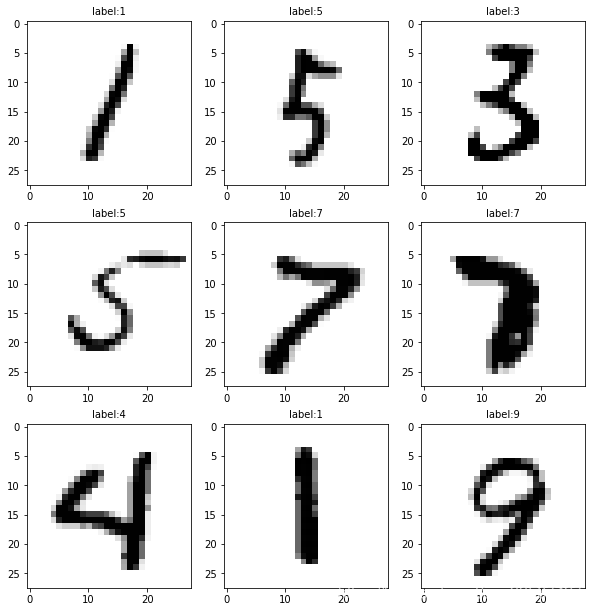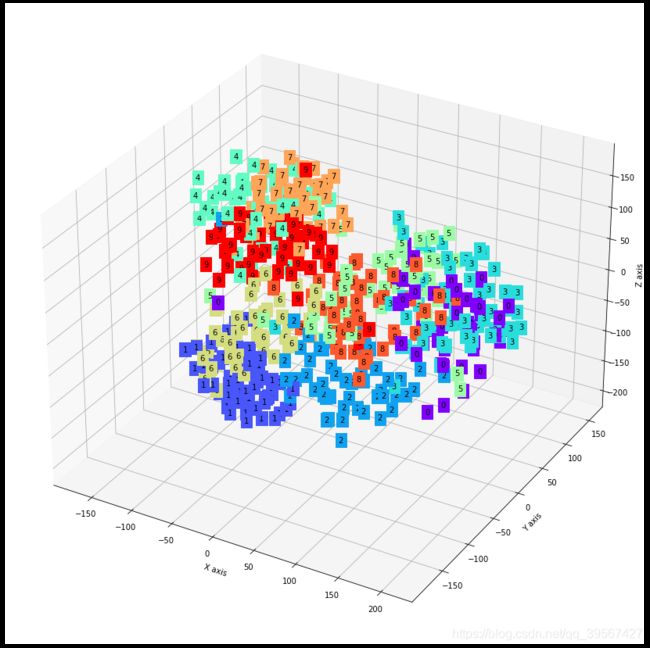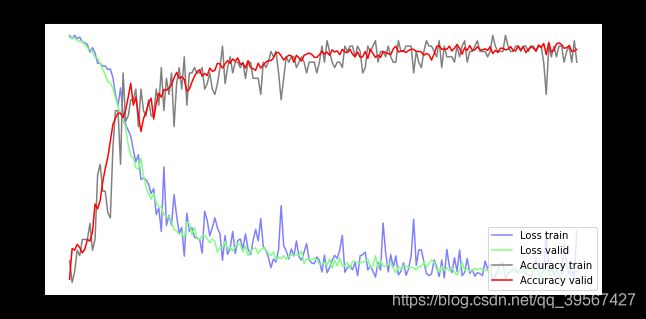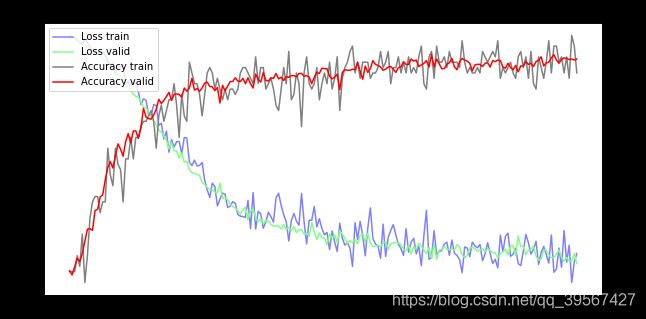PyTorch 笔记Ⅶ——mnist手写数字识别
文章目录
-
- 导入必要的包
- CNN网络
-
- 数据获取与处理
- 训练数据可视化
- 制作数据装载器及迭代器
- 获取设备信息
- 简易CNN网络构建
- 开始训练
- 训练效果可视化
- 获取测试集每类准去率
- 显存释放
- DNN网络
-
- 构建简易DNN模型
- 开始训练
- 训练效果可视化
- 获取每类测试准确率
- mnist嵌入动画绘制
导入必要的包
%matplotlib inline
import torch
import sys
import torch.nn as nn
import torch.utils.data as Data
import torchvision
from mpl_toolkits.mplot3d import Axes3D
import matplotlib.pyplot as plt
from matplotlib import cm
import numpy as np
from torchsummary import summary
import math
from sklearn.manifold import TSNE
CNN网络
数据获取与处理
torchvision.datasets.MNIST(root, train=True, transform=None, target_transform=None, download=False)
root (string): 数据集存储的目录MNIST/processed/training.pt以及MNIST/processed/test.pt存在的位置
train (bool, optional): 如果为True从training.pt创建数据集,否则从test.pt。主要作用就是指定创建训练集还是验证集
download (bool, optional): 如果为True就下载数据集到目标目录,否则不下载,但必须保证数据集已经存在
transform (callable, optional): 类型转换,主要将数据转换为Tensor类型
target_transform (callable, optional): 类型转换,转换标签数据为Tensor类型
train_data = torchvision.datasets.MNIST(
root='./mnist/',
train=True,
transform=torchvision.transforms.ToTensor(),
download=False,
)
print('训练集数据维度: ', train_data.data.size(), '\n训练集标签维度: ', train_data.targets.size())
训练集数据维度: torch.Size([60000, 28, 28])
训练集标签维度: torch.Size([60000])
训练数据可视化
def plot_num_images(num):
if num < 1:
print('INFO:The number of input pictures must be greater than zero!')
else:
choose_list = []
for i in range(num):
choose_n = np.random.randint(train_data.data.size()[0])
choose_list.append(choose_n)
fig = plt.gcf()
fig.set_size_inches(10, 3.5 * math.ceil(num / 3))
for i in range(num):
ax_img = plt.subplot(math.ceil(num / 3), 3, i + 1)
plt_img = train_data.data[choose_list[i]].numpy()
ax_img.imshow(plt_img, cmap='binary')
ax_img.set_title('label:' + str(train_data.targets[choose_list[i]].item()),
fontsize=10)
plt.show()
plot_num_images(9)
制作数据装载器及迭代器
设置批次大小
BATCH_SIZE = 50
训练数据装载器
train_loader = Data.DataLoader(dataset=train_data, batch_size=BATCH_SIZE, shuffle=True)
测试数据读取
test_data = torchvision.datasets.MNIST(root='./mnist/', transform=torchvision.transforms.ToTensor(), train=False)
print('测试集数据维度: ', test_data.data.size(), '\n测试集标签维度: ', test_data.targets.size())
测试集数据维度: torch.Size([10000, 28, 28])
测试集标签维度: torch.Size([10000])
测试数据装载器
test_loader = Data.DataLoader(dataset=test_data, batch_size=BATCH_SIZE * 10, shuffle=True)
获取设备信息
device = torch.device("cuda:0" if torch.cuda.is_available() else "cpu")
print(device)
cuda:0
简易CNN网络构建
class CNN(nn.Module):
'''
第一层:28x28x1
第二层:14x14x16
第三层:7x7x32
'''
def __init__(self):
super(CNN, self).__init__()
# 第一层卷积层
self.conv1 = nn.Sequential(
nn.Conv2d(
in_channels=1,
out_channels=16,
kernel_size=5,
stride=1,
padding=2),
nn.ReLU(),
nn.MaxPool2d(kernel_size=2)
)
# 第二层卷积
self.conv2 = nn.Sequential(
nn.Conv2d(16, 32, 5, 1, 2),
nn.ReLU(),
nn.MaxPool2d(2)
)
# 输出层
self.out = nn.Linear(32 * 7 * 7, 10)
def forward(self, x):
x = self.conv1(x)
x = self.conv2(x)
x = x.view(x.size(0), -1)
output = self.out(x)
return output, x
获取CNN网络摘要summary
cnn = CNN().to(device)
summary(cnn, input_size=(1, 28, 28))
----------------------------------------------------------------
Layer (type) Output Shape Param #
================================================================
Conv2d-1 [-1, 16, 28, 28] 416
ReLU-2 [-1, 16, 28, 28] 0
MaxPool2d-3 [-1, 16, 14, 14] 0
Conv2d-4 [-1, 32, 14, 14] 12,832
ReLU-5 [-1, 32, 14, 14] 0
MaxPool2d-6 [-1, 32, 7, 7] 0
Linear-7 [-1, 10] 15,690
================================================================
Total params: 28,938
Trainable params: 28,938
Non-trainable params: 0
----------------------------------------------------------------
Input size (MB): 0.00
Forward/backward pass size (MB): 0.32
Params size (MB): 0.11
Estimated Total Size (MB): 0.44
----------------------------------------------------------------
开始训练
设置超参数
EPOCHS = 1
LR = 0.001
STEPS=200
指定优化器与损失函数
optimizer = torch.optim.Adam(cnn.parameters(), lr=LR)
loss_func = nn.CrossEntropyLoss()
定义权重重置函数
def weight_reset(m):
if isinstance(m, torch.nn.Conv2d) or isinstance(m, torch.nn.Linear):
m.reset_parameters()
def plot_with_labels(lowDWeights, labels):
fig = plt.figure()
fig.set_size_inches(15, 15)
ax = fig.gca(projection='3d')
X, Y, Z = lowDWeights[:, 0], lowDWeights[:, 1], lowDWeights[:, 2]
for x, y, z, s in zip(X, Y, Z, labels):
c = cm.rainbow(int(255 * s / 9))
ax.text(x, y, z, s, backgroundcolor=c)
ax.set_xlim(X.min(), X.max())
ax.set_ylim(Y.min(), Y.max())
ax.set_zlim(Z.min(), Z.max())
ax.set_xlabel('X axis')
ax.set_ylabel('Y axis')
ax.set_zlabel('Z axis')
plt.show()
开始训练
%%time
# 权重初始化
cnn.apply(weight_reset)
# 建立迭代器iter
dataiter = iter(test_loader)
train_acc_list = []
test_acc_list = []
train_loss_list = []
test_loss_list = []
for epoch in range(EPOCHS):
for step, data in enumerate(train_loader):
# 数据提取并转为GPU形式
inputs, labels = data
inputs, labels = inputs.to(device), labels.to(device)
# 结果预测并获取预测值
outputs = cnn(inputs)[0]
train_pred_y = torch.max(outputs, 1)[1].data.squeeze()
# 获取准确率
train_acc = (train_pred_y == labels).sum().item() / float(labels.size(0))
# 获取损失值
loss = loss_func(outputs, labels)
train_loss_list.append(float(loss))
train_acc_list.append(train_acc)
# 反向传播
optimizer.zero_grad()
loss.backward()
optimizer.step()
# 异常处理标志
try:
images, targets = next(dataiter)
except StopIteration:
dataiter = iter(test_loader)
images, targets = next(dataiter)
# 数据提取并转为GPU形式
images, targets = next(dataiter)
images, targets = images.to(device), targets.to(device)
# 结果预测并获取预测值
test_outputs, last_layer = cnn(images)
test_pred_y = torch.max(test_outputs, 1)[1].data.squeeze()
# 获取准确率
test_acc = (test_pred_y == targets).sum().item() / float(targets.size(0))
test_acc_list.append(test_acc)
# 获取损失值
test_loss = loss_func(test_outputs, targets)
test_loss_list.append(float(test_loss))
sys.stdout.write(('\rOnly EPOCH 1, step={:3d}/{:3d}, train_loss={:.4f}, '
'train_acc={:.4f}, valid_loss={:.4f}, val_acc={:.4f}').format(step + 1,
STEPS,
loss,
train_acc,
test_loss,
test_acc))
if step == STEPS-1:
# 绘制出图像的数量最大值取决于数据的batchsize大小
tsne = TSNE(perplexity=30, n_components=3, init='pca', n_iter=5000)
low_dim_embs = tsne.fit_transform(last_layer.cpu().detach().numpy())
labels = targets.cpu().numpy()
plot_with_labels(low_dim_embs, labels)
break
Only EPOCH 1, step=200/200, train_loss=0.5322, train_acc=0.9000, valid_loss=0.1628, val_acc=0.9480
Wall time: 58.7 s
训练效果可视化
fig = plt.gcf()
fig.set_size_inches(10, 5)
ax1 = fig.add_subplot(111)
ax1.set_title('Train and Validation Picture')
ax1.set_ylabel('Loss value')
line1, = ax1.plot(train_loss_list, color=(0.5, 0.5, 1.0), label='Loss train')
line2, = ax1.plot(test_loss_list, color=(0.5, 1.0, 0.5), label='Loss valid')
ax2 = ax1.twinx()
ax2.set_ylabel('Accuracy value')
line3, = ax2.plot(train_acc_list, color=(0.5, 0.5, 0.5), label='Accuracy train')
line4, = ax2.plot(test_acc_list, color=(1, 0, 0), label='Accuracy valid')
plt.legend(handles=(line1, line2, line3, line4), loc='best')
plt.show()
获取测试集每类准去率
'''
设计思想:将每一类预测值与真实值进行对比,正确的为True
错误的为False,然后将所有的预测True相加,得到总的
预测正确的,最后除以总数量,得到每一类的正确率
'''
# 创建一个10维列表,存储后面每个类累计的值
class_correct = list(0. for i in range(10))
class_total = list(0. for i in range(10))
with torch.no_grad():
for data in test_loader:
images, labels = data
images, labels = images.to(device), labels.to(device)
# 独热码类型分布,输出为4x10的矩阵,分别表示batchsize:4以及类别:10
outputs = cnn(images)[0]
_, predicted = torch.max(outputs, 1)
# 将输入张量形状中的 1 去除并返回,例如[1, 2, 3]
# 返回[2, 3],当给定 dim 时,那么挤压操作只在给定维度
# 在这里由于返回的bool值,可以不使用.squeeze()操作
c = (predicted == labels).squeeze()
# 循环遍历每一个批次
for i in range(500):
label = labels[i]
# 获取具体值
class_correct[label] += c[i].item()
# 对应类别自加
class_total[label] += 1
for i in range(10):
print('Accuracy of %s : %2d %%' % (
i, 100 * class_correct[i] / class_total[i]))
Accuracy of 0 : 96 %
Accuracy of 1 : 97 %
Accuracy of 2 : 91 %
Accuracy of 3 : 99 %
Accuracy of 4 : 96 %
Accuracy of 5 : 92 %
Accuracy of 6 : 98 %
Accuracy of 7 : 93 %
Accuracy of 8 : 91 %
Accuracy of 9 : 89 %
显存释放
torch.cuda.empty_cache()
DNN网络
注意:本节沿用前面的数据处理,设备信息,重置函数等
构建简易DNN模型
class DNN(nn.Module):
def __init__(self):
super(DNN, self).__init__()
self.dnn = nn.Sequential(
nn.Linear(784, 64),
nn.ReLU(),
nn.Linear(64, 32),
nn.ReLU(),
nn.Linear(32, 10),
)
def forward(self, inputs):
return self.dnn(inputs)
dnn = DNN().to(device)
summary(dnn, input_size=(784, ))
----------------------------------------------------------------
Layer (type) Output Shape Param #
================================================================
Linear-1 [-1, 64] 50,240
ReLU-2 [-1, 64] 0
Linear-3 [-1, 32] 2,080
ReLU-4 [-1, 32] 0
Linear-5 [-1, 10] 330
================================================================
Total params: 52,650
Trainable params: 52,650
Non-trainable params: 0
----------------------------------------------------------------
Input size (MB): 0.00
Forward/backward pass size (MB): 0.00
Params size (MB): 0.20
Estimated Total Size (MB): 0.21
----------------------------------------------------------------
开始训练
构造优化器,损失函数与CNN相同
optimizer = torch.optim.Adam(dnn.parameters(), lr=LR)
开始训练
# 权重初始化
dnn.apply(weight_reset)
# 建立迭代器iter
dataiter = iter(test_loader)
train_acc_list = []
test_acc_list = []
train_loss_list = []
test_loss_list = []
for epoch in range(EPOCHS):
for step, data in enumerate(train_loader):
# 数据提取并转为GPU形式
inputs, labels = data
# 调整维度为784输入形式
inputs, labels = inputs.view([-1, 784]).to(device), labels.to(device)
# 结果预测并获取预测值
outputs = dnn(inputs)
train_pred_y = torch.max(outputs, 1)[1].data.squeeze()
# 获取准确率
train_acc = (train_pred_y == labels).sum().item() / float(labels.size(0))
# 获取损失值
loss = loss_func(outputs, labels)
train_loss_list.append(loss.cpu().detach().numpy())
train_acc_list.append(train_acc)
# 反向传播
optimizer.zero_grad()
loss.backward()
optimizer.step()
# 异常处理标志
try:
images, targets = next(dataiter)
except StopIteration:
dataiter = iter(test_loader)
images, targets = next(dataiter)
# 数据提取并转为GPU形式
images, targets = next(dataiter)
# 调整维度为784输入形式
images, targets = images.view([-1, 784]).to(device), targets.to(device)
# 结果预测并获取预测值
test_outputs = dnn(images)
test_pred_y = torch.max(test_outputs, 1)[1].data.squeeze()
# 获取准确率
test_acc = (test_pred_y == targets).sum().item() / float(targets.size(0))
test_acc_list.append(test_acc)
# 获取损失值
test_loss = loss_func(test_outputs, targets)
test_loss_list.append(test_loss)
print(('Only EPOCH 1, step={:3d}/{:3d}, train_loss={:.4f}, '
'train_acc={:.4f}, valid_loss={:.4f}, val_acc={:.4f}').format(step + 1,
STEPS,loss.cpu().detach().numpy(),
train_acc,
test_loss.cpu().detach().numpy(),
test_acc))
if step == STEPS-1:
break
Only EPOCH 1, step= 1/200, train_loss=2.3101, train_acc=0.1000, valid_loss=2.2895, val_acc=0.1040
Only EPOCH 1, step= 2/200, train_loss=2.2876, train_acc=0.1000, valid_loss=2.2929, val_acc=0.0880
Only EPOCH 1, step= 3/200, train_loss=2.2973, train_acc=0.1000, valid_loss=2.2793, val_acc=0.1180
Only EPOCH 1, step= 4/200, train_loss=2.2723, train_acc=0.1600, valid_loss=2.2575, val_acc=0.1500
Only EPOCH 1, step= 5/200, train_loss=2.2470, train_acc=0.1200, valid_loss=2.2581, val_acc=0.1380
Only EPOCH 1, step= 6/200, train_loss=2.2328, train_acc=0.2400, valid_loss=2.2445, val_acc=0.1680
Only EPOCH 1, step= 7/200, train_loss=2.2757, train_acc=0.0600, valid_loss=2.2285, val_acc=0.2140
Only EPOCH 1, step= 8/200, train_loss=2.2522, train_acc=0.1600, valid_loss=2.2131, val_acc=0.2580
Only EPOCH 1, step= 9/200, train_loss=2.2120, train_acc=0.3000, valid_loss=2.1965, val_acc=0.2600
Only EPOCH 1, step= 10/200, train_loss=2.1720, train_acc=0.3600, valid_loss=2.2000, val_acc=0.2540
..................................................................................................
Only EPOCH 1, step=190/200, train_loss=0.5802, train_acc=0.8400, valid_loss=0.3852, val_acc=0.8960
Only EPOCH 1, step=191/200, train_loss=0.2577, train_acc=0.9400, valid_loss=0.3847, val_acc=0.9080
Only EPOCH 1, step=192/200, train_loss=0.2869, train_acc=0.9400, valid_loss=0.4161, val_acc=0.8880
Only EPOCH 1, step=193/200, train_loss=0.4679, train_acc=0.8800, valid_loss=0.4495, val_acc=0.8760
Only EPOCH 1, step=194/200, train_loss=0.3008, train_acc=0.9000, valid_loss=0.3848, val_acc=0.8900
Only EPOCH 1, step=195/200, train_loss=0.6192, train_acc=0.8400, valid_loss=0.3539, val_acc=0.8960
Only EPOCH 1, step=196/200, train_loss=0.3442, train_acc=0.9000, valid_loss=0.3859, val_acc=0.8940
Only EPOCH 1, step=197/200, train_loss=0.4924, train_acc=0.8200, valid_loss=0.3569, val_acc=0.8900
Only EPOCH 1, step=198/200, train_loss=0.1697, train_acc=0.9800, valid_loss=0.3529, val_acc=0.8920
Only EPOCH 1, step=199/200, train_loss=0.3478, train_acc=0.9400, valid_loss=0.4220, val_acc=0.8880
Only EPOCH 1, step=200/200, train_loss=0.4201, train_acc=0.8400, valid_loss=0.3337, val_acc=0.8920
训练效果可视化
fig = plt.gcf()
fig.set_size_inches(10, 5)
ax1 = fig.add_subplot(111)
ax1.set_title('Train and Validation Picture')
ax1.set_ylabel('Loss value')
line1, = ax1.plot(train_loss_list, color=(0.5, 0.5, 1.0), label='Loss train')
line2, = ax1.plot(test_loss_list, color=(0.5, 1.0, 0.5), label='Loss valid')
ax2 = ax1.twinx()
ax2.set_ylabel('Accuracy value')
line3, = ax2.plot(train_acc_list, color=(0.5, 0.5, 0.5), label='Accuracy train')
line4, = ax2.plot(test_acc_list, color=(1, 0, 0), label='Accuracy valid')
plt.legend(handles=(line1, line2, line3, line4), loc='best')
plt.show()
获取每类测试准确率
'''
设计思想:将每一类预测值与真实值进行对比,正确的为True
错误的为False,然后将所有的预测True相加,得到总的
预测正确的,最后除以总数量,得到每一类的正确率
'''
# 创建一个10维列表,存储后面每个类累计的值
class_correct = list(0. for i in range(10))
class_total = list(0. for i in range(10))
with torch.no_grad():
for data in test_loader:
images, labels = data
images, labels = images.view([-1, 784]).to(device), labels.to(device)
# 独热码类型分布,输出为4x10的矩阵,分别表示batchsize:4以及类别:10
outputs = dnn(images)
_, predicted = torch.max(outputs, 1)
# 将输入张量形状中的 1 去除并返回,例如[1, 2, 3]
# 返回[2, 3],当给定 dim 时,那么挤压操作只在给定维度
# 在这里由于返回的bool值,可以不使用.squeeze()操作
c = (predicted == labels).squeeze()
# 循环遍历每一个批次
for i in range(50):
label = labels[i]
# 获取具体值
class_correct[label] += c[i].item()
# 对应类别自加
class_total[label] += 1
for i in range(10):
print('Accuracy of %s : %2d %%' % (
i, 100 * class_correct[i] / class_total[i]))
Accuracy of 0 : 95 %
Accuracy of 1 : 99 %
Accuracy of 2 : 89 %
Accuracy of 3 : 86 %
Accuracy of 4 : 81 %
Accuracy of 5 : 86 %
Accuracy of 6 : 93 %
Accuracy of 7 : 87 %
Accuracy of 8 : 74 %
Accuracy of 9 : 90 %
mnist嵌入动画绘制
这里提供了一份绘制嵌入图像的代码mnist_embedding_plot.py,里面集成了一小部分训练这样方便展现结果
import torch
import torch.nn as nn
import torch.utils.data as Data
import torchvision
from mpl_toolkits.mplot3d import Axes3D
import matplotlib.pyplot as plt
from matplotlib import cm
import numpy as np
import math
import sys
from sklearn.manifold import TSNE
BATCH_SIZE = 50
EPOCHS = 1
LR = 0.001
STEPS=200
device = torch.device("cuda:0" if torch.cuda.is_available() else "cpu")
train_data = torchvision.datasets.MNIST(
root='./mnist/',
train=True,
transform=torchvision.transforms.ToTensor(),
download=False,
)
train_loader = Data.DataLoader(dataset=train_data, batch_size=BATCH_SIZE, shuffle=True)
test_data = torchvision.datasets.MNIST(root='./mnist/', transform=torchvision.transforms.ToTensor(), train=False)
test_loader = Data.DataLoader(dataset=test_data, batch_size=BATCH_SIZE * 10, shuffle=True)
class CNN(nn.Module):
'''
第一层:28x28x1
第二层:14x14x16
第三层:7x7x32
'''
def __init__(self):
super(CNN, self).__init__()
# 第一层卷积层
self.conv1 = nn.Sequential(
nn.Conv2d(
in_channels=1,
out_channels=16,
kernel_size=5,
stride=1,
padding=2),
nn.ReLU(),
nn.MaxPool2d(kernel_size=2)
)
# 第二层卷积
self.conv2 = nn.Sequential(
nn.Conv2d(16, 32, 5, 1, 2),
nn.ReLU(),
nn.MaxPool2d(2)
)
# 输出层
self.out = nn.Linear(32 * 7 * 7, 10)
def forward(self, x):
x = self.conv1(x)
x = self.conv2(x)
x = x.view(x.size(0), -1)
output = self.out(x)
return output, x
cnn = CNN().to(device)
optimizer = torch.optim.Adam(cnn.parameters(), lr=LR)
loss_func = nn.CrossEntropyLoss()
def weight_reset(m):
if isinstance(m, torch.nn.Conv2d) or isinstance(m, torch.nn.Linear):
m.reset_parameters()
def plot_with_labels(lowDWeights, labels):
fig = plt.figure()
fig.set_size_inches(15, 15)
ax = fig.gca(projection='3d')
X, Y, Z = lowDWeights[:, 0], lowDWeights[:, 1], lowDWeights[:, 2]
for x, y, z, s in zip(X, Y, Z, labels):
c = cm.rainbow(int(255 * s / 9))
ax.text(x, y, z, s, backgroundcolor=c)
ax.set_xlim(X.min(), X.max())
ax.set_ylim(Y.min(), Y.max())
ax.set_zlim(Z.min(), Z.max())
ax.set_xlabel('X axis')
ax.set_ylabel('Y axis')
ax.set_zlabel('Z axis')
plt.axis('off')
plt.show()
# 权重初始化
cnn.apply(weight_reset)
# 建立迭代器iter
dataiter = iter(test_loader)
train_acc_list = []
test_acc_list = []
train_loss_list = []
test_loss_list = []
for epoch in range(EPOCHS):
for step, data in enumerate(train_loader):
# 数据提取并转为GPU形式
inputs, labels = data
inputs, labels = inputs.to(device), labels.to(device)
# 结果预测并获取预测值
outputs = cnn(inputs)[0]
train_pred_y = torch.max(outputs, 1)[1].data.squeeze()
# 获取准确率
train_acc = (train_pred_y == labels).sum().item() / float(labels.size(0))
# 获取损失值
loss = loss_func(outputs, labels)
train_loss_list.append(float(loss))
train_acc_list.append(train_acc)
# 反向传播
optimizer.zero_grad()
loss.backward()
optimizer.step()
# 异常处理标志
try:
images, targets = next(dataiter)
except StopIteration:
dataiter = iter(test_loader)
images, targets = next(dataiter)
# 数据提取并转为GPU形式
images, targets = next(dataiter)
images, targets = images.to(device), targets.to(device)
# 结果预测并获取预测值
test_outputs, last_layer = cnn(images)
test_pred_y = torch.max(test_outputs, 1)[1].data.squeeze()
# 获取准确率
test_acc = (test_pred_y == targets).sum().item() / float(targets.size(0))
test_acc_list.append(test_acc)
# 获取损失值
test_loss = loss_func(test_outputs, targets)
test_loss_list.append(float(test_loss))
sys.stdout.write(('\rOnly EPOCH 1, step={:3d}/{:3d}, train_loss={:.4f}, '
'train_acc={:.4f}, valid_loss={:.4f}, val_acc={:.4f}').format(step + 1,
STEPS,
loss,
train_acc,
test_loss,
test_acc))
if step == STEPS-1:
# 绘制出图像的数量最大值取决于数据的batchsize大小
tsne = TSNE(perplexity=30, n_components=3, init='pca', n_iter=5000)
low_dim_embs = tsne.fit_transform(last_layer.cpu().detach().numpy())
labels = targets.cpu().numpy()
plot_with_labels(low_dim_embs, labels)
break
效果如下(由于CSDN显示图片上传大小,所以我压缩了一下的♂️):



